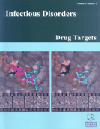- Home
- A-Z Publications
- Infectious Disorders - Drug Targets (Formerly Current Drug Targets - Infectious Disorders)
- Previous Issues
- Volume 12, Issue 1, 2012
Infectious Disorders - Drug Targets (Formerly Current Drug Targets - Infectious Disorders) - Volume 12, Issue 1, 2012
Volume 12, Issue 1, 2012
-
-
Foreword
More LessAs an Editor-in-Chief of the journal ‘Infectious Disorders - Drug Targets’, I am very pleased to announce that it is now an internationally well-recognized and competitive journal with an always growing audience in various areas of research, such as virology, bacteriology, medicinal chemistry, pharmacology, biochemistry, molecular biology and genomics. By publishing both timely in-depth review articles (see special Read More
-
-
-
Editorial [Hot Topic: Subcellular Trafficking of Pathogens: Targeting for Therapeutics (Guest Editors: Gregory W. Moseley and David A. Jans)]
More LessAuthors: Gregory W. Moseley and David A. JansConventional therapies for microbial infection including vaccines, antibiotics and antivirals principally target specific properties of the microbe, such as antigen expression, attachment proteins for host cell interaction and entry, and microbial enzymes involved in replication and assembly. The efficacy of such approaches to protect human populations from disease is limited by the ability of known microbial pathogens to mutate Read More
-
-
-
Tetraspanins - Gateways for Infection
More LessAuthors: Peter N. Monk and Lynda J. PartridgeThe tetraspanins constitute a conserved superfamily of four-span membrane proteins that are widely distributed in multi-cellular organisms. A characteristic property of tetraspanins is their ability to form lateral associations with one another and with other membrane proteins, giving rise to tetraspanin enriched microdomains (TEM) that are involved in the molecular organisation of many membrane-associated functions such Read More
-
-
-
Viral Product Trafficking to Mitochondria, Mechanisms and Roles in Pathogenesis
More LessAuthors: Chad D. Williamson, Roberta L. DeBiasi and Anamaris M. Colberg-PoleyA wide variety of viruses cause significant morbidity and mortality in humans. However, targeted antiviral therapies have been developed for only a subset of these viruses, with the majority of currently licensed antiviral drugs targeting viral entry, replication or exit steps during the viral life cycle. Due to increasing emergence of antiviral drug resistant viruses, the isolation of multiple viral subtypes, and toxicities of existing therapie Read More
-
-
-
Subcellular Trafficking in Rhabdovirus Infection and Immune Evasion: A Novel Target for Therapeutics
More LessAuthors: Sibil Oksayan, Naoto Ito, Greg Moseley and Danielle BlondelVesicular stomatitis virus (VSV) and Rabies Virus (RABV) are the prototypic members of the rhabdovirus family. These viruses have a particularly broad host range, and despite the availability of vaccines, RABV still causes more than 50,000 human deaths a year. Trafficking of the virion or viral particles is important at several stages of the replicative life cycle, including cellular entry, localization into the cytoplasmic inclusion bod Read More
-
-
-
Modulation of Host Cell Nucleocytoplasmic Trafficking During Picornavirus Infection
More LessAuthors: Parisa Younessi, David A. Jans and Reena GhildyalPicornavirus infection is characterised by host cell shutoff, wherein host transcription and translation processes are severely impaired. Picornavirus proteins interact with host cell proteins, resulting in alterations in the host cell synthetic, signalling and secretory machinery, and facilitating transcription and translation of viral proteins to achieve increased virus replication and assembly. Among the many cellular pathways aff Read More
-
-
-
Artificial Viruses: Exploiting Viral Trafficking for Therapeutics
More LessImproved understanding of the signals that direct the intracellular transport of endogenous mammalian proteins, as well as the means by which viral invaders hijack transport pathways during infection, has revealed a plethora of methods for enhancing drug and gene delivery. Multi-component delivery vectors with virus-like functionality are being developed to assemble with therapeutic DNA into structured nanoparti Read More
-
-
-
Antiretroviral Therapy Does Not Block the Secretion of the Human Immunodeficiency Virus Tat Protein
More LessAuthors: Sonia Mediouni, Albert Darque, Gilbert Baillat, Isabelle Ravaux, Catherine Dhiver, Herve Tissot-Dupont, Malika Mokhtari, Herve Moreau, Catherine Tamalet, Corinne Brunet, Pascale Paul, Francoise Dignat-George, Andreas Stein, Philippe Brouqui, Stephen A. Spector, Grant R. Campbell and Erwann P. LoretTat is a viral protein secreted from HIV infected cells and extra cellular Tat is suspected to prevent destruction of HIV infected cells from cells of the cellular immunity. The effect of anti retroviral therapy (ART) on Tat secretion has never been investigated. In this study, we tested for antibody reactivity against Tat variants representative of the main HIV subtypes in HIV positive patients receiving ART with undetectable viral load Read More
-
Volumes & issues
-
Volume 25 (2025)
-
Volume 24 (2024)
-
Volume 23 (2023)
-
Volume 22 (2022)
-
Volume 21 (2021)
-
Volume 20 (2020)
-
Volume 19 (2019)
-
Volume 18 (2018)
-
Volume 17 (2017)
-
Volume 16 (2016)
-
Volume 15 (2015)
-
Volume 14 (2014)
-
Volume 13 (2013)
-
Volume 12 (2012)
-
Volume 11 (2011)
-
Volume 10 (2010)
-
Volume 9 (2009)
-
Volume 8 (2008)
-
Volume 7 (2007)
-
Volume 6 (2006)
Most Read This Month
Article
content/journals/iddt
Journal
10
5
false
en


